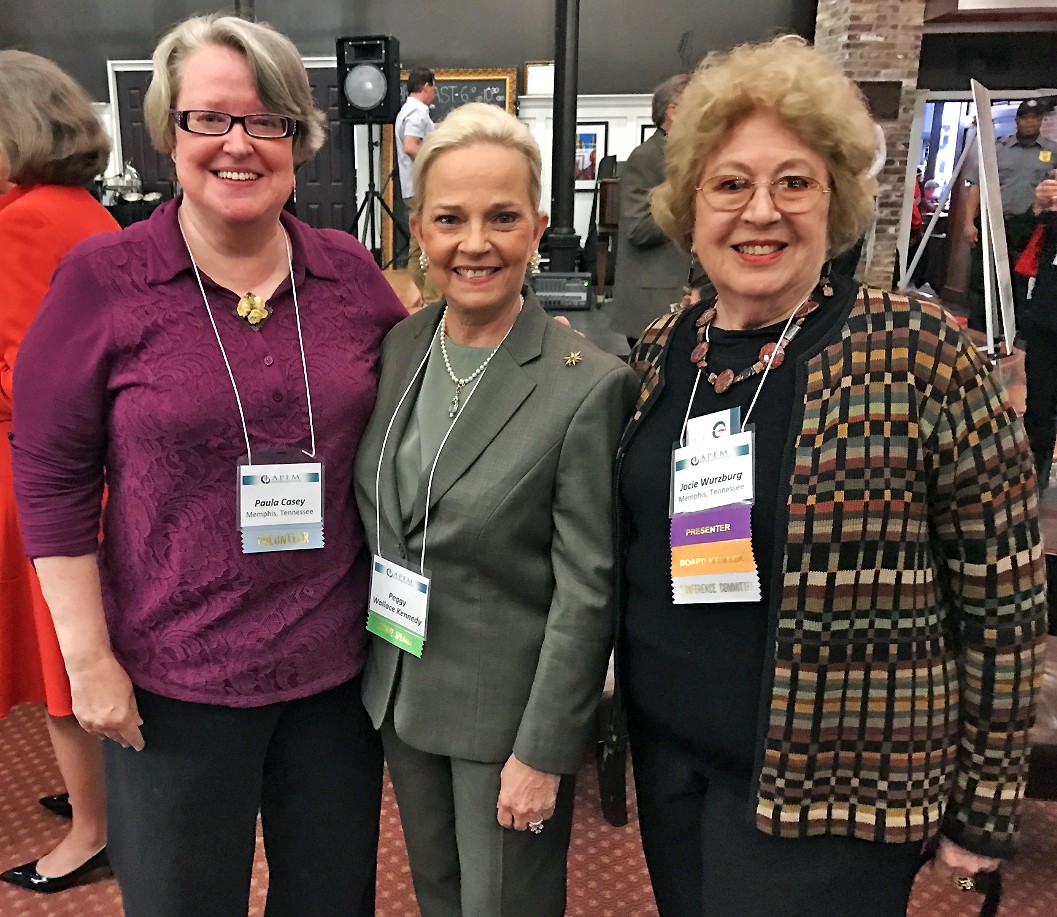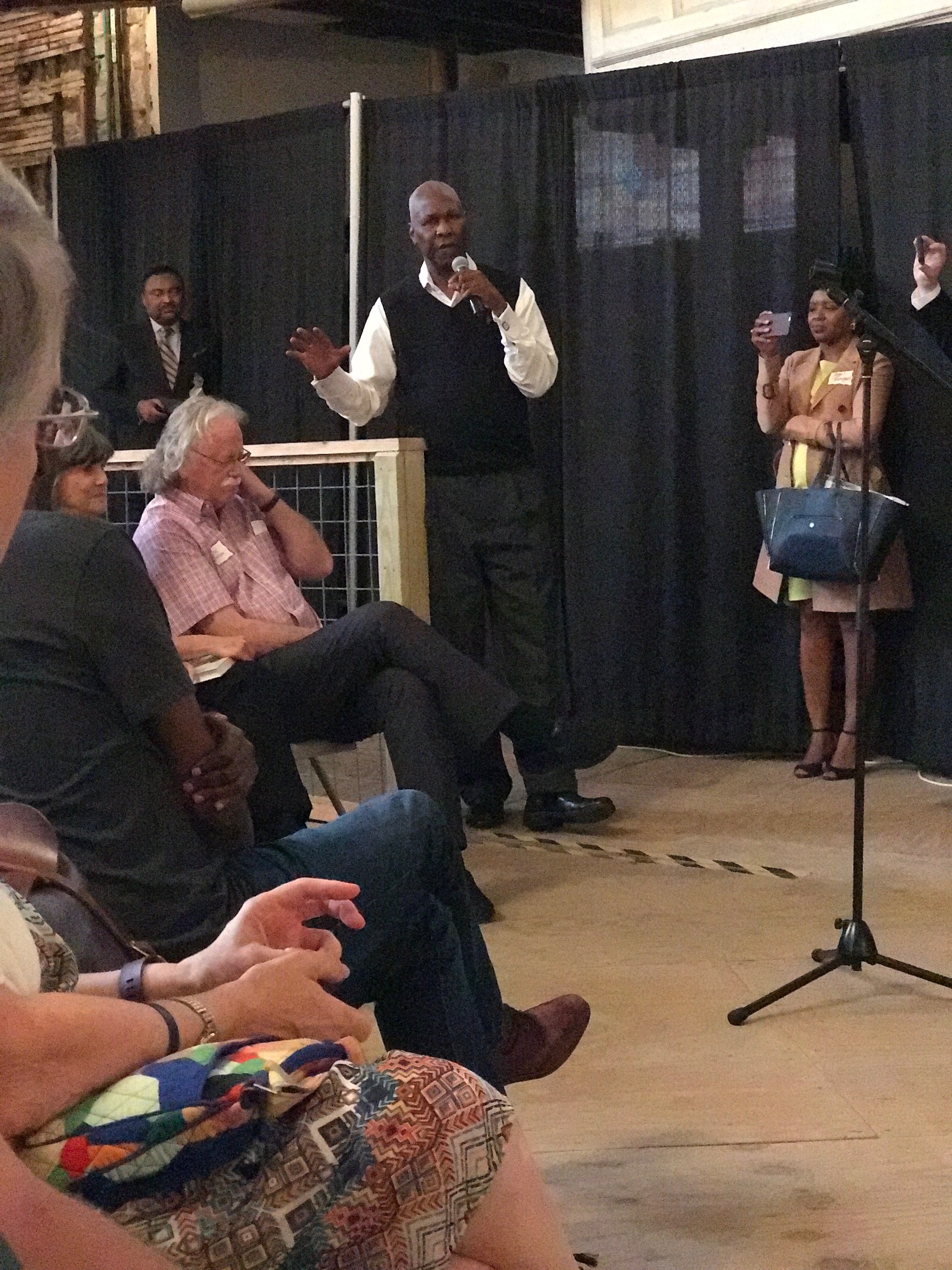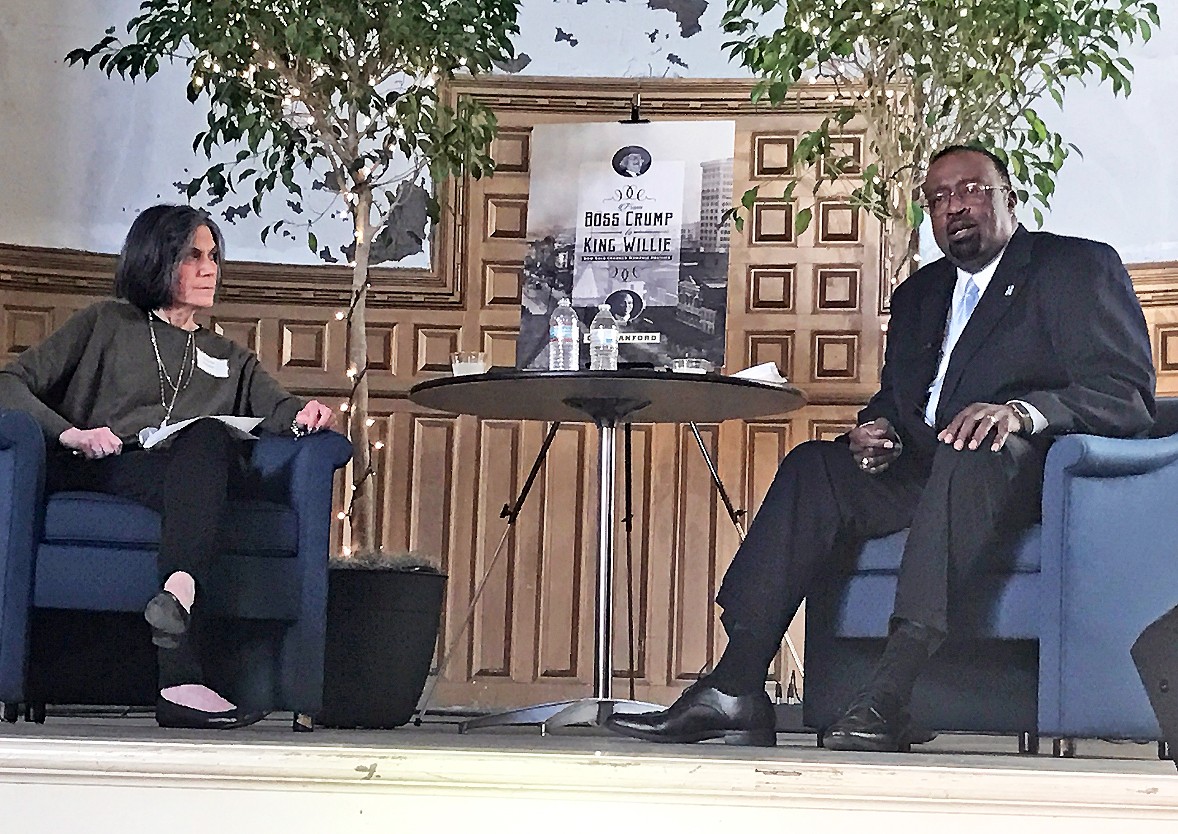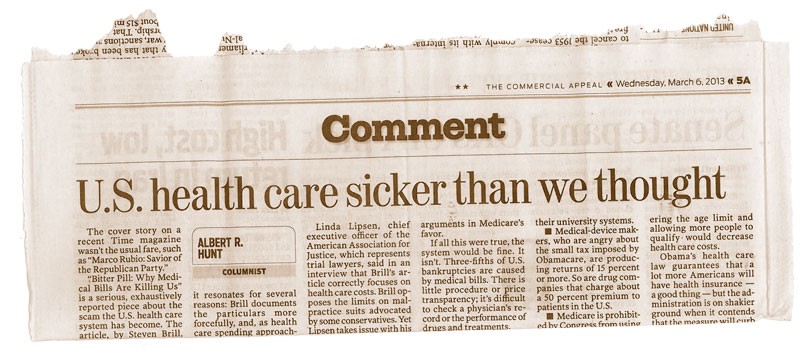From outside those shiny windows of The Commercial Appeal headquarters at 495 Union, there’s a perception that things are tense inside. Over the years, the paper has been hit hard from many angles, toiling in a daily newspaper industry experts call “beleaguered” and “strained” when they’re trying to be nice about it (and “dead” when they are not).
Many cycles of newsroom layoffs and worries about future newsroom layoffs have created what is now a routine kind of stress at the CA, according to sources. But if, as expected, the Gannett Co.’s deal to buy the paper is done, that old tension will sharpen.
The Commercial Appeal will have a new owner, one that’s notorious for shrinking newsrooms. For an example, look 200 miles east to Nashville’s daily, The Tennessean. Last year, Gannett implemented its “Newsroom of the Future” project there, which entailed firing the newspaper’s entire newsroom and making them reapply for their jobs, a move that bled veteran reporters from the ranks in what’s been called a “massive exodus.”
If the Gannett deal is done, the CA will have had three owners in the span of about a year. The paper, which had been owned by the Cincinnati-based E.W. Scripps Co. since 1936, was sold in April to the Journal Media Group. That lasted until October, when Journal Media announced that it was merging with Gannett.
Stormy skies and unpredictable seas, indeed. But inside the newsroom at 495 Union, there’s also an undercurrent of routine calm.
“There’s apprehension. A lot of people are concerned about job security and the kind of changes that might be coming,” says Wayne Risher, a business reporter for the CA and president of the Memphis Newspaper Guild. “I think it’d be the same no matter who the buyer is. Just the act of being sold again so soon after April 1st just has people kind of on edge. Still, everyone has a job to do. People are going about their business.”
The Deal
On October 7th, Milwaukee-based Journal Media Group and McLean, Virginia-based Gannett announced a deal that would merge Journal Media (which was six months old at the time) into the Gannett portfolio of newspapers. Gannett said it would pay $280 million (or $12 a share to Journal Media stockholders) for the 15 daily papers and 18 weeklies that Journal Media owned in 14 markets.
Market watchers told The Wall Street Journal that Journal Media was valued at $192 million when the Gannett deal was announced, meaning Gannett paid a fat premium ($88 million over market value) for the takeover.
But the deal was “highly attractive” to Gannett, according to documents filed with the Securities and Exchange Commission [SEC], because it would add $450 million in annual revenues (the top line) and about $60 million each year to earnings (the bottom line).
But the deal would also consolidate some corporate and administrative functions that could save the combined companies $35 million annually. This (called corporate synergy) is a concept that means a combined company is more valuable together than as separate entities. It increases share prices to stockholders, and is usually what makes merger deals attractive in the first place. “Synergy” also likely means job cuts and service cuts and, according to the newspaper groups, they’ve found $35 million worth of them.
The deal would give Gannett a total reach into 106 local markets across the country, in addition to its flagship national paper, USA Today. The new papers would give Gannett’s total print circulation a bump of about 1.6 million. Websites for the acquired newspapers would add about 10 million unique digital visitors a month to Gannett’s digital network, for a combined total of about 100 million monthly unique visitors.
Gannett is a newspaper-only company now, having spun off its broadcast division last year, and it’s on the hunt to aggressively expand its print empire. Experts say print companies are cheap compared to years past, and Gannett is set to gobble them up.
Here’s how Robert J. Dickey, Gannett president and CEO, said the Journal Media purchase fits into the new strategy: “This transaction is an excellent first step in the industry consolidation strategy we have communicated to our shareholders and is a good example of the value-creating opportunities we believe are available.”
The deal still has to get approval from Journal Media shareholders and federal antitrust regulators, though few believe the deal will face much government pushback. If all goes according to plan, the deal will be done in the first three months of 2016.
 Justin Fox Burks
Justin Fox Burks
What We Know
Unknowns abound about what might happen if Gannett does purchase The Commercial Appeal. But thanks to public merger documents filed with the SEC, we do know a few things (or, at least we know what the companies say):
•Newsroom layoffs: Gannett won’t lay off anyone in the CA newsroom (or the newsroom of any Journal Media paper) for one year after the deal is closed.
A clause in the merger document says “for a period of not less than 12 months” after the deal is done, Gannett is to “maintain the editorial staffing levels existing” just before the deal was done “in all newsrooms” of Journal Media Group and its subsidiaries.
However, Risher isn’t so sure the statement will hold. Attorneys for the Newspaper Guild said the clause isn’t legally binding and is more like a statement of intent between Journal Media and Gannett.
“If they don’t follow it — if they do come in and make wholesale changes — (the Guild) would have no standing,” Risher said. “No one outside of Journal Media and Gannett have any standing to do anything about any part of that agreement that doesn’t get followed.”
He said the Guild wouldn’t be able to file a grievance if Gannett went back on its word. Still, though, Risher said the clause does give some “reassurance that there won’t be any big changes right off the bat.”
•Customers: Nothing should change for subscribers or advertising clients of the CA. Journal Media says “subscriptions will continue uninterrupted.” Advertisers and “key partners” will continue to work with their current sales reps.
•Syndication: Content generated at the CA will be syndicated across a new network that will include all Gannett properties, called the “USA Today Network.” With it, Gannett hopes to “bring the nation’s largest news gathering force together.”
•Outside content: You’ll find USA Today content (and other Gannett news) in the CA in print and online. Journal Media says, however, that “Gannett is committed to investing in differentiated relevant local reporting.”
•Website: Commercialappeal.com will likely be integrated to the Gannett platform. The document was unclear as to whether or not we’ll see a newly designed website for the CA, which just got an overhaul this year, complete with a marketing campaign pumping its content.
Richard Thompson, a former CA reporter and now a Memphis media critic who writes the Mediaverse blog, said a USA Today-style website for the paper is one of the things he’s most dreading about Gannett’s possible ownership.
“It’s cookie-cutter,” Thompson said. “You want Memphis to have a website or a news service that reflects the value and the nature of the city. That’s one of the things you had [on commercialappeal.com] before Scripps started centralizing everything.”
•Benefits: No changes are expected for employees’ base pay, vacation, or insurance (at least through 2016).
•The Journal Media Group brand will disappear.
What We Don’t Know
•Management: “No decisions have been made yet” as to whether or not Journal Media managers will join Gannett. But leaders from the two companies will meet soon to “review staffing needs.” This could mean key leaders at the CA could leave.
•Layoffs: The merger document says, “certain jobs may be affected as plans are enacted to streamline operations between the two companies.” Laid-off employees will be offered a company-paid severance package and COBRA health insurance.
•Integration: “Specific integration plans have not yet been determined,” the merger document says. Though, it notes that The Commercial Appeal will be part of a network with papers such as The Arizona Republic, The Indianapolis Star, The Des Moines Register, and The Detroit Free Press.
•Newspapers: Journal Media was vague as to whether all of its papers will survive. It says that its portfolio of newspapers “complements” Gannett’s but doesn’t say outright that they don’t overlap. “We anticipate that we will be able to leverage our combined resources for the benefit of both readers and advertisers.”
Layoffs and Memphis
Layoffs have been frequent at the CA in recent years. The first question Memphians want to know is usually how many were let go in the newsroom?
All of this attention paid to one Memphis company may seem excessive to some. Why aren’t long, detailed news stories written about layoffs at every company?
Former CA editorial editor Otis Sanford said it’s simple: Reporters watch out for their communities. Sanford is now a media professor at the University of Memphis but he started as a Commercial Appeal reporter in 1977 and still writes a weekly opinion column. Sanford saw the first rounds of layoffs after he was promoted to managing editor in 2002.
People who really care about news and information in Memphis, Sanford said, know that the CA is best positioned to cover hard news, tell important stories, and uncover what’s been covered up.
“They want to see news covered, and they want to see [oversight on the] government — the watchdog responsibility that news organizations have. They want to see that fulfilled,” Sanford said. “That’s why they get worried when they hear about layoffs. They worry that they don’t have enough folks down there to check on city hall or county government or the school systems or the environment or education.”
Bruce Dobie is a former editor of the Nashville Scene and a former columnist for The Tennessean. He watched Gannett’s Newsroom of the Future project bleed reporters from the Nashville daily. Soon after that, Dobie and some investors tried to buy The Tennessean, according to a story by the Nashville Scene, but Gannett rejected the deal. Dobie and others have since purchased the long-defunct daily Nashville Banner and are trying to revive it.
Asked why he thought newsroom reductions hit so hard in a community, Dobie said that newspapers, in general, are still important because social media — while ubiquitous — is unreliable when it comes to reporting the truth.
“You have to have instruments of record that really attempt to arrive at the correct version of events in a city. Newspapers are still the best medium for that,” Dobie said. “I’d argue that newspapers are the best version of the truth that you can find in any American market today. So, it’s vital for us as citizens in our communities to have a common understanding of the environments in which we live, and for that we turn to newspapers.”
Gannett and the Newsroom of the Future
When it comes to American newspapers, nobody’s bigger than Gannett. The company has more than 90 papers all across the country and, of course, “America’s newspaper,” USA Today.
When asked what Gannett ownership of the CA may bring, many point to The Tennessean. Gannett has owned the paper since the 1970s, and it didn’t make any radical changes for many years. But in 2006, Gannett debuted its “Newsroom of the Future” project to reinvent its newsrooms to compete in a digital marketplace. It rolled out the new newsroom structure in four newspapers, including The Tennessean, last year. Gone were many of the traditional newsroom titles, replaced by job descriptions such as “community content editor,” “content coach,” “engagement editor,” and other online-era monikers.
To fill these jobs, The Tennessean fired its entire news staff and made them reapply for their jobs (under the new titles). In the end, according to the Nashville Scene, about 15 percent of the news staff was cut. That list included a travel and society writer, a copy editor, two high school sports writers, a Predators beat reporter, and a photographer.
The paper’s executive editor at the time, Stefanie Murray, wrote that the move was a “bold step forward in our evolution.”
But the move opened the floodgates. In the following months, many reporters, including several veteran beat reporters, became fed up with the company and moved on, according to the Scene.
“It was a massive exodus of people,” Dobie said.
Whether Gannett will take such drastic measures at the CA remains to be seen. However, Risher said someone asked Gannett CEO Dickey about the move to fire everyone and have them reapply for their jobs, and he said it was a model the company wasn’t sticking with.
Dobie said such cutbacks in the newspaper business are not unique to Nashville or even Gannett. The company has to show stock value growth to shareholders, and in an age of declining print revenues, cuts are the next preferred method to get there.
Ken Paulson agreed. He spent nearly 20 years working with Gannett. He was one of the first team members at USA Today and rose to become the paper’s editor-in-chief. He’s now the president of the First Amendment Center and dean of the College of Media and Entertainment at Middle Tennessee State University.
Paulson said he’s not a Gannett apologist, but he said there have been “countless examples” of new owners making newsroom cutbacks all over the country and pointed to recent examples at the Los Angeles Times and ESPN.
“New owners are always trying to improve profit margins,” Paulson said. “I suspect there will be that kind of scrutiny applied to every newspaper Gannett owns. … If you’re a reporter in Memphis, you have every right to wonder [about layoffs], but that would be the case no matter which ownership interest came in.”
Newsroom cuts and even the threat of newsroom cuts made it tough for some to stomach a news report last week from the Milwaukee Business Journal. The paper reported that if the Gannett deal closes on time, Journal Media Group CEO Tim Stautberg would get a payday of $4.56 million for less than a year’s work.
Gannett Will Dominate Tennessee
Another fact about Gannett’s possible purchase of Journal Media emerged in analysis following the news announcement. If the deal gets done, Gannett will own nearly every major newspaper in the state of Tennessee.
It owns the The Tennessean, The Jackson Sun, The Daily News Journal (Murfreesboro), and The Leaf-Chronicle (Clarksville). The new deal would give it The Commercial Appeal and The Knoxville News Sentinel. (The Chattanooga Times Free Press remains privately owned by WEHCO Media, a family company.)
For those with corporate media conspiracy theories, the Gannett deal in Tennessee is a smorgasbord. Gannett would theoretically be able to tell each of its editorial boards whom to endorse for public office.
Paulson said in all his years at Gannett, he never saw corporate intervention in editorial board policy. Why? ”It’s simple,” he said, ”money.”
“You have to remember that for a company like Gannett, profit is the greatest priority,” Paulson said. “There’s really no percentage in getting entangled in local politics. They’re looking for high (website) traffic numbers and as healthy a circulation number as they can deliver.”
Thompson said that he was less concerned about corporations as kingmaker and more concerned that news will lose its Memphis focus once reporters from across the state begin contributing to The Commercial Appeal.
“I think Memphis readers, Memphis people, are very news-centric, they know their news,” Thomspon said. He said the change might further diminish the CA‘s work on “heavy news.”
New Faces in High Places
Thompson’s fears are backed up by what Dobie said he saw in Nashville last year. At one point, he said, the publisher and the editor of The Tennessean had collectively lived in the city for less than 18 months.
“[Another problem] was the fact that the editors and publishers [Gannett] brings in to run these markets usually know very little about the character and soul and personality of the markets for which they’re supposed to be publishing a newspaper,” Dobie said.
Dobie predicted an “immediate change” in the management for the CA. That prediction corners one of the few concerns Sanford said he had with the Gannett deal, the possible replacement of newsroom leaders Louis Graham as editor and Mark Russell as managing editor.
For now, it’s largely a wait-and-see game for the CA. That game has been played for a long time by veteran employees. It’s by no means any fun, according to a former newsroom employee.
“One of the things that was hardest to deal with was this cloud of dread and uncertainty that hung over you every single day, because you kept thinking: Am I next?” the former staffer said, on the condition of anonymity.
Layoffs came in shocking waves over the years, the former employee said, and were unannounced and unexpected. One minute a colleague was there, and the next moment they were gone.
After landing another job, the former employee said he had a revelation.
“When I got that offer, I was thrilled that somebody wanted me,” the former employee said. “You had that whole Stockholm Syndrome where you’re treated as if you’re expendable. ‘You should give all you’ve got for [the paper], but just know we may get rid of you at any second.'”
Risher said the Guild’s contract will be recognized by Gannett and that his group will try to meet with the company this month. But, he said, he doesn’t have a whole lot of insight into the proceedings of the merger deal.
Risher was resigned to the purchase, however, noting that Gannett is probably good at making cuts by now, and that, as far as dealing with a new company, “We’ve been dealing with a kind of hostile management here going back 30 years.”
He said his CA colleagues soldier on inside those shiny windows at 495 Union out of a sense of duty, but also because the future is largely out of their hands.
“That’s all you can do,” he said. “It’s not going to do any good to worry about what might happen. We’ll just wait and see what comes and deal with it when it happens.”



 JB
JB  JB
JB  JB
JB  Justin Fox Burks
Justin Fox Burks 





